

Suboptimization Meaning. How to overcome organizational silos? How to overcome organisational silos Have you got problems finding a common language and cooperation from people around the organisation for customer experience initiatives?
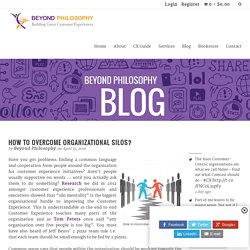
Aren’t people usually supportive on words … until you actually ask them to do something? Research we did in 2012 amongst customer experience professionals and executives showed that “silo mentality” is the biggest organisational hurdle to improving the Customer Experience. This is understandable as the end to end Customer Experience touches many parts of the organization and as Tom Peters once said “any organisation over five people is too big”. You must have also heard of Jeff Bezos’ 2 pizza team rule i.e. that each team should be small enough to be fed by 2 pizzas.
Common sense says that people within the organisation should be working towards the same goal but reality is different. As an article in Fast Company says: Consequences Destroy trust. Breaking down organisational silos [polldaddy poll=7036189] Breaking Down Silos. Breaking Down Organizational Barriers. Silo Breakthroughs - Creating a Powerful Middle Team. In-group favoritism. In-group favoritism, sometimes known as in-group–out-group bias, in-group bias, intergroup bias, or in-group preference, is a pattern of favoring members of one's in-group over out-group members.
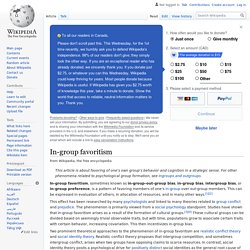
This can be expressed in evaluation of others, in allocation of resources, and in many other ways.[1][2] This effect has been researched by many psychologists and linked to many theories related to group conflict and prejudice. The phenomenon is primarily viewed from a social psychology standpoint. Studies have shown that in-group favoritism arises as a result of the formation of cultural groups.[3][4] These cultural groups can be divided based on seemingly trivial observable traits, but with time, populations grow to associate certain traits with certain behavior, increasing covariation.
This then incentivizes in-group bias. Two prominent theoretical approaches to the phenomenon of in-group favoritism are realistic conflict theory and social identity theory. Explanations[edit] Competition[edit] Group attribution error. The group attribution error refers to people's tendency to believe either the characteristics of an individual group member are reflective of the group as a whole, ora group's decision outcome must reflect the preferences of individual group members, even when external information is available suggesting otherwise.[1][2][3] The group attribution error shares an attribution bias analogous to the fundamental attribution error.[2] Rather than focusing individual's behavior, it relies on group outcomes and attitudes as its main for conclusions.
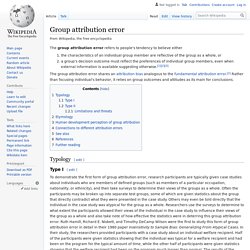
Typology[edit] Type I[edit] To demonstrate the first form of group attribution error, research participants are typically given case studies about individuals who are members of defined groups (such as members of a particular occupation, nationality, or ethnicity), and then take surveys to determine their views of the groups as a whole. Integrating Your Way... By Diana Lilla, PMP As a child, did you work on jigsaw puzzles with your family?
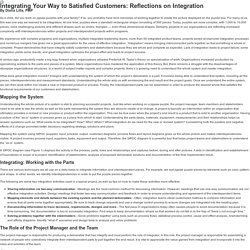
If so, you probably have fond memories of working together to create the picture displayed on the puzzle box. For many of us, this was one way we learned to be integrators. At one time, puzzles were a standard rectangular shape consisting of 500 pieces. Today, puzzles are more complex, with 1,000 to 10,000 pieces, more challenging pictures and different shapes such as circles, triangles — even three-dimensional shapes. My experience with complex programs and organizations, multiple integrated leadership teams, more than 50 integrated product teams, projects aimed at improved integration processes and numerous mergers has given me a great appreciation for the value of effective integration. A century ago, productivity made a big leap forward when organizations adopted Frederick W. What does great integration involve? Mapping the System Integrating: Working with the Parts. Silos, Politics, and Turf Wars - Notes & Review.
Patrick Lencioni.
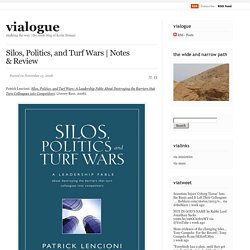
Silos, Politics, and Turf Wars: A Leadership Fable About Destroying the Barriers that Turn Colleagues into Competitors. (Jossey-Bass, 2006). As with Lencioni’s other books, Silos is a fable/parable that helps to illustrate the realities of these dysfunctions in real-life situations. While I felt that this story was slightly weaker, (and I do mean “slightly”) than the others I’ve read (perhaps I’m getting too “used” to his style now), it is still poignant, and I still very much enjoy the practicality of the real-life setting.
As with the others, often times it’s best to sum up from the back of the book, to the front. Silos are nothing more than the barriers that exist between departments within an organization, causing people who are supposed to be on the same team to work against one another. A few things that seemed appropriate to note. Book - Silos, Politics and Turf War. Establishing a Thematic Goal Roadmap. Silos - Thematic Goal. Author Q&A Pat Lencioni - Silos Politics and Turf Wars. Collective / Shared Leadership.